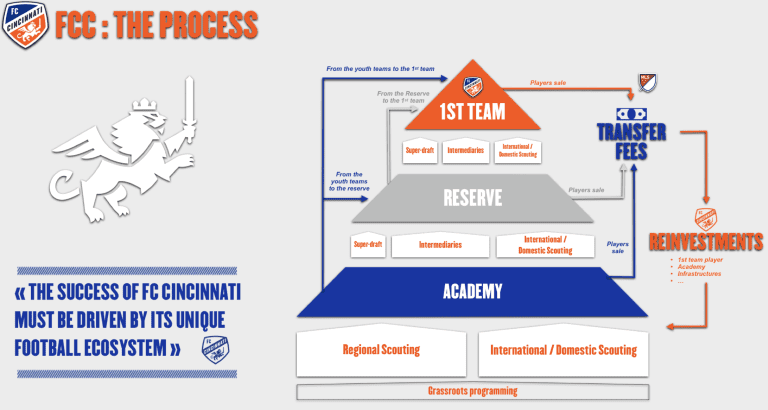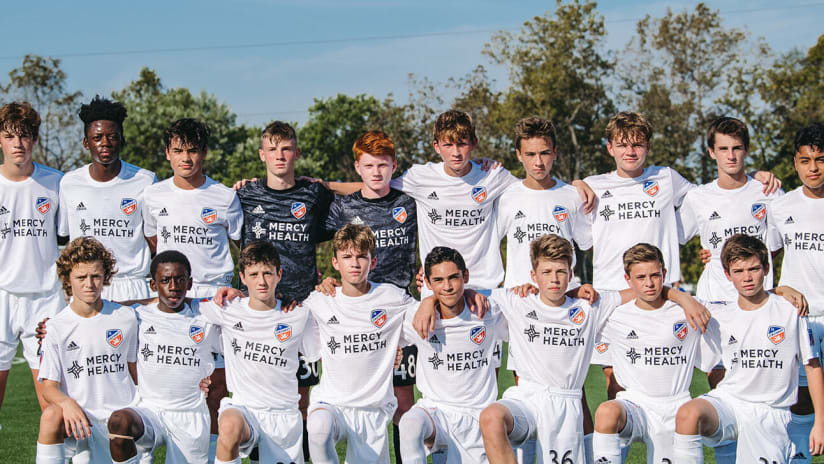Gerard Nijkamp and Larry Sunderland have always talked about FC Cincinnati expanding and ultimately completing their player development pathway. Its completion got one step closer Wednesday afternoon.
Later this summer, FCC will have five youth teams after the team announced the creation of an Under-19 side and the Pre-Academy Under-13 and Under-14 teams.
While the latter includes the two youngest teams, the Academy will now have U-15, U-17 and U-19 teams to advance player development and bring the Orange and Blue one step closer to signing Homegrown players to their MLS roster.
In one quick announcement – long in the making and planning, however – FC Cincinnati just more than doubled the length of its player development pathway, creating more opportunities – spanning extended age ranges – for the region’s brightest-playing prospects to develop and potentially move up to the first team roster in the coming years.
“We’ve always held the belief that we need to be the ones to push soccer to a higher level in our region,” said Sunderland, the director of player development and FCC Academy director. “Expanding our development pyramid allows greater access to our system for more players, families and coaches in our region.”
Opportunity is the main takeaway from Wednesday’s news. As Sunderland said, there’s now a clear pathway for a player to start with the U-13 side and work his way toward becoming an MLS Homegrown signee playing in West End Stadium.
A player’s growth isn’t restricted to age, of course – just look at Ricardo Pepi (FC Dallas) and Gianluca Busio (Sporting Kansas City), who both played against FCC last year at the age of 16. But by Cincinnati adding more teams, it fills in the club’s playing pyramid while creating more opportunities for players to grow in the club’s ecosystem.
An example of what a player’s pathway might resemble

Imagine a 13-year old midfielder joins the youngest Pre-Academy team in a few months. He’ll have up to two years before the FCC Academy staff decides if the player has the ability to graduate to the Academy’s U-15 side.
Once in the formal Academy, he could play with the Under-15s, then the Under-17s and ultimately in the Under-19s or even for the first team if he has the talent and commitment to make the leap early.
Clubs around the world use their academies as a pipeline, and while Cincinnati has always been committed to doing the same, it now has a longer onramp to bring players along.
By bridging the gap and filling the pyramid, FCC has a stronger chance to find the next great, young Homegrown who’ll make an impact in the league, like some of the most recent examples:
- Paxton Pomykal is MLS’ most hyped Homegrown. Joining the FC Dallas Academy in 2014, he’s only 20 but has been playing for the first team since 2017. Now, he’s already capped by the U.S. Men’s National Team and one of the country’s brightest talents.
- Philadelphia Union’s Brenden Aaronson is only 19, but he’s been in the Union environment longer than most of his first-team teammates because of his time in the club’s youth system. He’s played for the USMNT, too.
- LA Galaxy’s Efraín Álvarez is 17 and has made 14 appearances for the club. He made 20 appearances for Los Dos – their USL Championship side – and joined the LAG Academy in 2016. He became the USL’s youngest signing at 15 years old and is an example of what an academy can produce.
Differences between the FCC Academy and Pre-Academy
All teams will be fully funded when it comes to equipment and training, but there are slight differences with the Academy and Pre-Academy
For the FCC Academy, Sunderland said it includes “extensive” travel, meaning the Orange and Blue will compete around the country and even internationally in tournaments. The club continues to pay 100% of all costs related to playing in the Academy.
For the Pre-Academy, travel will be local and regional with parents or guardians, so there will be a “traditional model” there in regards to travel costs.
“The goal for the program is really to get players into our system younger, so they gives them a longer lead time until where we have to make a decision finally to say, ‘Yes, this player is on the pro pathway or this player is on a different pathway,’ which could be a university pathway,” Sunderland said.
“It just allows them to get into our system and into our culture, our playing style, our principles. It’s just a longer runway of development for us, so it’s a positive.”




